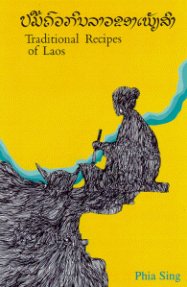Burmese Recipes
Cambodian Recipes
Lao Recipes
Thai Recipes
Vietnamese Recipes
Book Reviews
Submit Review


by Galanga Gastronaut
The Best Book on Lao Food
Traditional Recipes of Laos, the first book entirely devoted to Lao cookery, was published in 1981. As the first of its kind, it bore the simple but difficult burden of being informative, accurate and aesthetic. By all means the book fulfilled its requirements, and has since been a valued part of many libraries. Its only problem was that it was poorly distributed and not widely available, making it nearly impossible to acquire. That problem was rectified in 1995 by a second printing and again in 2000 by a third.
In content the new edition is identical to the first, except that the facsimile copies of the original recipes written in Lao are now omitted. The first fifty pages, written by the book’s editors Alan and Jennifer Davidson, provide a valuable introduction to Lao eating habits, measures, batterie de cuisine, cooking techniques and ingredients. It’s a gastronomical treasure trove, and should be a delightful read even for someone who thinks himself already familiar with Lao cookery. Davidson is among the world’s most prominent food writers and his talent is evident here. His description of pa va, for example, is fascinating:
"Pa va, LABEO DYOCHEILUS, is a kind of carp which is well-known in parts of India and in Burma also…In the rivers near Luang Prabang it attains a maximum length of 45 cm, although to hear Luang Prabang fishermen talk you would think that it was closer to the maximum size which it reaches in India, 1 metre. The pa va was the favourite quarry of H.R.H. The Crown Prince when he went fishing…He described to the senior editor of this book how a fortunate fisherman may sometimes catch three at once while they are performing their ‘danse d’amour’ (in which two males rub themselves, one on each side, against a female, in order to squeeze out the eggs). This happens when the pa va come down the tributaries, in July and August, to spawn in the Mekong. The eggs, incidentally, are among those most prized for making ‘caviar’, which is done by salting them."
Alan Davidson’s peculiar erudition can partially be accounted for by his tenure as Her Majesty the British Queen’s ambassador to Laos during the country’s transition from Kingdom to "Democratic Republic." He left Laos in the autumn of 1975, the same year he’d published Fish and Fish Dishes of Laos. The first book he’d published, it launched the diplomat’s second and phenomenal career as a food writer. But Davidson is only a secondary star in this book…
The recipes here are all those of Chaleunsilp Phia Sing, who was Chef and Master of Ceremonies at the Luang Prabang court before his death in 1967. The collection encompasses a broad range, with many classic Lao dishes, some dishes of foreign origin and some dishes of Phia Sing’s own creation, which are often the most interesting. Davidson describes him as "a sort of Laotian Leonardo da Vinci," and I couldn’t help but admire the way in which he works foreign ingredients and techniques into Lao cookery, accruing to himself the possible distinction of being the first chef of Lao fusion cuisine. Progressive in his approach, Phia Sing writes, "since cooking utensils and certain vegetables from foreign countries have been imported, cooking can be done with greater convenience and in a better organized and hygienic way; the science of cooking and feeding people has developed with the passage of time." This is an important thing to keep in mind, because traditional Lao cookery tends to be time consuming. But it needn’t be with modern tools. For example, while most Lao would shrink in horror from the thought of grinding or even chopping up meat for laap/koy before cooking it, this is nevertheless the approach that all Thai restaurants that serve the dish take. The process would otherwise take too much time. The blender and food processor is an important tool for modern Lao cookery, and its possibilities need to be explored. It is hard to believe that there are still people using the "rabbit" scraper to make coconut milk when a blender does the a superior job and with greater efficiency. Unfortunately Phia Sing died before he could get a food processor, but his words and his approach suggest that he would have advocated its use, and probably without compromising the "traditional" character of his recipes.
This is an extraordinary book. Every Lao thinks he knows how to cook Lao food, but it is obvious that Phia Sing’s repertoire far exceeds the average home cook’s. Particularly valuable are the recipes for the sa dishes (sa ton sin ngua, sa ton pa va, sa soy sin fahn). These are made from thin slices of raw beef, venison or fish dressed with a little salt and acidulated with lime, then tossed with a variety of herbs. More refined and aristocratic than laap or koy, they also underline the uniqueness of Lao cuisine.
The book is throughout beautifully illustrated by Lao artists, primarily the accomplished Soun Vannithone, who also illustrated Davidson’s recent Oxford Companion to Food. Traditional Recipes of Laos is priceless, and belongs on the shelf of every Lao and anyone with even a vague interest in Lao cuisine. The book is usually out of print, so in order to avoid years waiting for a new printing, it’s best to purchase it as soon as possible.
Traditional Recipes of Laos ($20) by Phia Sing and edited by Alan and Jennifer Davidson is published by Prospect Books, Devon, England. The book can be ordered through Prospect’s distributor in the United States, Food Words. Food Words can be contacted by email.
copyright 2012 galanga.com
